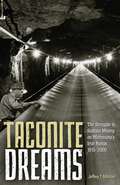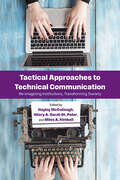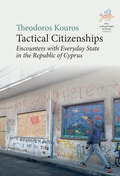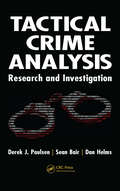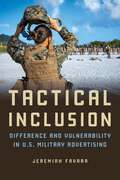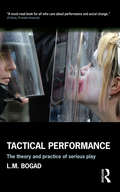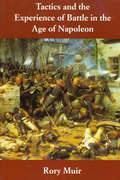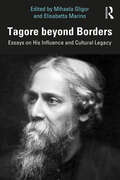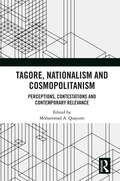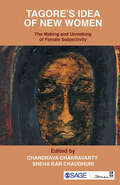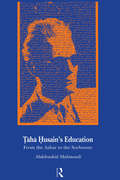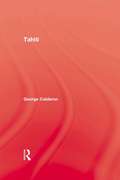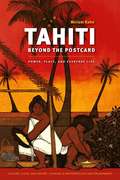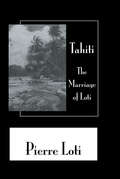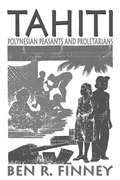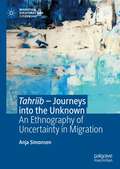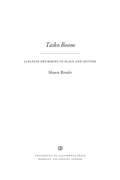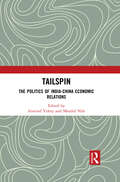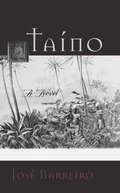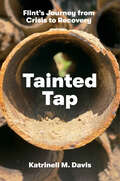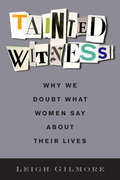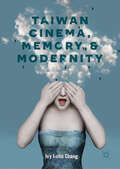- Table View
- List View
Taconite Dreams: The Struggle to Sustain Mining on Minnesota’s Iron Range, 1915-2000
by Jeffrey T. ManuelWinner of the Midwestern History Association's 2016 Hamlin Garland Prize The Iron Range earned its name honestly: it was once among the world&’s richest iron ore mining districts. The Iron Range propelled the U.S. steel industry in the late nineteenth century, and iron mining sustained generations in the region with work and a strong economy. But long before most other parts of the country faced the realities of industrial decline, Minnesota&’s Iron Range was already striving to maintain its core industry.In Taconite Dreams: The Struggle to Sustain Mining on Minnesota&’s Iron Range, 1915–2000, Jeffrey T. Manuel examines how the region fought the dislocation that came with economic changes, technological advances, and global shifts in industrial production. On the Iron Range, efforts included the development of taconite mining as a technological fix for the drop in hematite mining. Manuel describes the Iron Range&’s modern history and how the downturn was opposed by individuals, civic groups, and commercial interests. The first book dedicated to thoroughly exploring this era on the Iron Range, Taconite Dreams demonstrates how the area fit into a larger story of regions wrestling with deindustrialization in the twentieth century. The 1964 taconite amendment to Minnesota&’s constitution, the bruising federal pollution lawsuit that closed a taconite plant, and the Iron Range Resources and Rehabilitation Board&’s economic development policy are all discussed.Ultimately, the resistance against economic decline is also a battle over mining&’s memory and legacy, one that continues today. Manuel&’s history sheds much-needed light on this important yet widely overlooked mining region as well as the impact of the past century&’s struggles on the people who call it home.
Tactical Approaches to Technical Communication: Reimagining Institutions, Transforming Society (SUNY series, Studies in Technical Communication)
by Hayley McCullough; Hilary A. Sarat-St. Peter; Miles A. KimballDelves into how individuals tactically exist within communicative systems, carving out spaces for themselves in places they don't necessarily fit.In 1984, Michel de Certeau described the terms "strategies" as how institutions communicate their wants/demands/desires and "tactics" as how individuals navigate these potentially hostile, unwelcoming systems. A little over two decades later, Miles A. Kimball solidified the idea of tactical technical communication, laying the foundations for a new area of inquiry and scholarship. Today, many academics and researchers have imbued the concept of tactical technical communication with their own ideas and perspectives. This essay collection spotlights a meaningful diversity of tactical technical communication scholarship, exploring topics like the feminist punk magazine BIKINI KILL, the phenomenon of copwatching, the usage of fictional narratives in technical writing courses, and the challenges of LBGTQ+ visibility in local libraries. In many ways, the contributors are partaking in their own forms of tactical communication as they carve out spaces for themselves and their ideas within the academic discourse.
Tactical Citizenships: Encounters with Everyday State in the Republic of Cyprus (New Anthropologies of Europe: Perspectives and Provocations #8)
by Theodoros KourosThe idea of citizenship is formed through a dynamic and flexible set of relationships that go beyond a sequence of formal rights and duties. It is recurring in everyday social contexts—in practices that play out in the real world, in the everyday exercises or refusals of citizenship rights, in the purposeful defiance of norms, and in the tactical evasion of duties. This book explores the troubled relationship between a state and its citizens across four different kinds of social spaces in Limassol, Cyprus. Tactical Citizenships is a testament to the tenacity and resourcefulness of citizens of unfair states in directing their relations with the government.
Tactical Crime Analysis: Research and Investigation
by Derek J. Paulsen Sean Bair Dan HelmsResearch has shown that the majority of crimes are committed by persistent or serial offenders, with as little as seven percent of offenders accounting for approximately 60 percent of all crimes. By focusing police efforts on these prolific offenders and learning to identify, analyze, and resolve the crimes they commit, the law enforcement communit
Tactical Inclusion: Difference and Vulnerability in U.S. Military Advertising (Feminist Media Studies)
by Jeremiah FavaraThe revolution in military recruitment advertising to people of color and women played an essential role in making the US military one of the most diverse institutions in the United States. Starting at the dawn of the all-volunteer era, Jeremiah Favara illuminates the challenges at the heart of military inclusion by analyzing recruitment ads published in three commercial magazines: Sports Illustrated, Cosmopolitan, and Ebony. Favara draws on Black feminism, critical race theory, and queer of color critique to reveal how the military and advertisers affected change by deploying a set of strategies and practices called tactical inclusion. As Favara shows, tactical inclusion used representations of servicemembers in the new military to connect with people susceptible to recruiting efforts and rendered these new audiences vulnerable to, valuable to, and subject to state violence. Compelling and eye-opening, Tactical Inclusion combines original analysis with personal experience to chart advertising’s role in building the all-volunteer military.
Tactical Media (Electronic Mediations #28)
by Rita RaleyTactical media describes interventionist media art practices that engage and critique the dominant political and economic order. Rather than taking to the streets and staging spectacular protests, the practitioners of tactical media engage in an aesthetic politics of disruption, intervention, and education. From They Rule, an interactive map of the myriad connections between the world&’s corporate and political elite created by Josh On and Futurefarmers, toBlack Shoals, a financial market visualization that is intended to be both aesthetically and politically disruptive, they embrace a broad range of oppositional practices.In Tactical Media, Rita Raley provides a critical exploration of the new media art activism that has emerged out of, and in direct response to, postindustrialism and neoliberal globalization. Through close readings of projects by the DoEAT group, the Critical Art Ensemble, Electronic Civil Disobedience, and other tactical media groups, she articulates their divergent methods and goals and locates a virtuosity that is also boldly political. Contemporary models of resistance and dissent, she finds, mimic the decentralized and virtual operations of global capital and the post-9/11 security state to exploit and undermine the system from within. Emphasizing the profound shift from strategy to tactics that informs new media art-activism, Raley assesses the efficacy of its symbolic performances, gamings, visualizations, and hacks. With its cogent analyses of new media art and their social impact, Tactical Media makes a timely and much needed contribution to wider debates about political activism, contemporary art, and digital technology.
Tactical Performance: Serious Play and Social Movements
by Larry BogadTactical Performance tells fun, mischievous stories of underdogs speaking mirth to power - through creative, targeted activist performance in the streets of cities around the world. This compelling, inspiring book also provides the first ever full-length practical and theoretical guide to this work. L.M.Bogad, one of the most prolific practitioners and scholars of this genre, shares the most effective non-violent tactics and theatrics employed by groups which have captured the public imagination in recent years. Tactical Performance explores carnivalesque protest in unique depth, looking at the possibilities for direct action and sometimes shocking confrontation with some of the most powerful institutions in the world. It is essential reading for anyone interested in creative pranksterism and the global justice movement.
Tactics and the Experience of Battle in the Age of Napoleon
by Rory MuirThis historical study of Napoleonic battles and tactics examines firsthand accounts from soldiers&’ memoirs, diaries, and letters: &“A major work&” (David Seymour, Military Illustrated). In this illuminating volume, historian Rory Muir explores what actually happened in battle during the Napoleonic Wars, putting special focus on how the participants&’ feelings and reactions influenced the outcome. Looking at the immediate dynamics of combat, Muir sheds new light on how Napoleon&’s tactics worked. This analysis is enhanced with vivid accounts of those who were there—the frightened foot soldier, the general in command, the young cavalry officer whose boils made it impossible to ride, and the smartly dressed aide-de-camp, tripped up by his voluminous pantaloons. Muir considers the interaction of artillery, infantry, and cavalry; the role of the general, subordinate commanders, staff officers, and aides; morale, esprit de corps, soldiers&’ attitudes toward death and feelings about the enemy; the plight of the wounded; the difficulty of surrendering; and the way victories were finally decided. He discusses the mechanics of musketry, artillery, and cavalry charges and shows how they influenced the morale, discipline, and resolution of the opposing armies. "Muir has filled an important gap in the study of the Napoleonic era."—Library Journal
Tactics of Interfacing: Encoding Affect in Art and Technology (Leonardo)
by Ksenia FedorovaHow digital technologies affect the way we conceive of the self and its relation to the world, considered through the lens of media art practices.In Tactics of Interfacing, Ksenia Fedorova explores how digital technologies affect the way we conceive of the self and its relation to the world. With the advent of ubiquitous computing, the self becomes an object of technological application, increasingly defined by data received from tracking technologies. Subtly, these technologies encourage versions of ourselves that are easier to interpret computationally. Fedorova views these shifts in self-perception through the lens of contemporary media art practices, examining a range of artistic tactics that enable embodied and intimate experiences of machinic operations on our lives.
Tagore beyond Borders: Essays on His Influence and Cultural Legacy
by Mihaela Gligor Elisabetta MarinoThis book looks at Rabindranath Tagore’s creative art, social commitment, literary and artistic representation and his unique legacy in the cultural history of modern India – as a blend of the quintessentially Indian and the liberal universalist. Tagore’s genius, which he expressed through his poetry, songs, paintings, drama and philosophy, is celebrated across the globe. In 1913, he was awarded the Nobel Prize for Literature for his volume of poetry, Gitanjali (Song Offerings), making him the first Nobel laureate from Asia. This volume of essays celebrates his intellectual engagements and his incredible legacy by discussing the diverse ways in which his works have been reinterpreted, adapted and translated over the years. It analyses his perspectives on modernity, nationalism, liberation, education, post-colonialism and translatability and their relevance today. The leitmotif is a Tagore who, while imaginable as made possible only within the Indian tradition, eludes attempts aimed at identification with a national culture and remains a "cosmopolitan" in the best sense of the term.This volume will be of interest to readers and researchers in the fields of literature, philosophy, political science, cultural studies, Asian studies, South Asian studies and Tagore studies. Fans of Tagore will also find this an interesting read as it presents many little knows aspects of the poet’s work.
Tagore, Nationalism and Cosmopolitanism: Perceptions, Contestations and Contemporary Relevance
by Mohammad A. QuayumThis book is a fresh examination of Rabindranath Tagore’s ideas on nationalism and his rhetoric of cosmopolitanism. It critically analyses the poetics and the politics of his works and specifically responds to Tagore’s three lectures on nationalism delivered during the early years of the twentieth century and later compiled in his book Nationalism (1917). This volume: Discusses Tagore’s perception of nationalism – the many-sidedness of his engagement with nationalism, the root causes of his anathema against the ideology, ambiguities and limitations associated with his perception and his alternative vision of cosmopolitanism or global unity; Cross-examines an alternative view of cosmopolitanism based on Tagore’s inclusivist ideology to “seek my compatriots all over the world”; Explores how his ideas on nationalism and cosmopolitanism found myriad expressions across his works – in prose, fiction, poetry, travelogue, songs – as well as in the legacy of cinematic adaptations of his writings; Investigates the relevance of Tagore’s thoughts on nationalism and cosmopolitanism in relation to the contemporary rise of religious, nationalist and sectarian violence in the twenty-first century. A key study on the relevance of Tagore’s political philosophy in the contemporary world with contributions from eminent Tagore scholars in South Asia as well as the West, this book will be of great interest to readers and researchers in the fields of literature, political science, cultural studies, philosophy and Asian studies.
Tagore′s Ideas of the New Woman: The Making and Unmaking of Female Subjectivity
by Chandrava Chakravarty Sneha Kar ChaudhuriA notable contribution on Tagore’s vision of womanhood This book theorizes the continuous reconfigurations—‘making’ and ‘unmaking’—of female subjectivity in Tagore’s life, his times, and his works. This transhistorical approach in the book makes gender formations and discourses of the past relevant and necessary to the understanding of postmodern gender issues and ideologies. A unique feature of this compilation is the variety of genres that it covers, ranging from Tagore’s poems, dance dramas, dance forms and their innovative uses, the gender-specific nature of several Rabindrasangeet, his travel writings and paintings, to highlighting the postmodern reworks of Tagore’s novels on celluloid. On the whole, this edited collection with its extensive focus on the issues of gender, heterosexual love, marriage and patriarchy in relation to the works of Tagore strengthens the claim that the politics of culture and the gendering of social subjectivity were intrinsic to the representative ideologies of literature of the nineteenth and twentieth century.
Taha Husain's Education: From Al Azhar to the Sorbonne
by Abdelrashid MahmoudiTaha Husein is rightly regarded as the father of modern Arabic literature and his work is widely used as introductory texts for students of the language. In this highly original book, Dr Mahmoudi describes Husein's cultural and intellectual journey through his education in Egypt and France. Husein's humanism and modernism can be traced from his time at the al Azhar through his time in the influential circle of Ahmad Lutfi al-Sayyid to his famous study mission to France, where he witnessed the twilight of positivism. Taha Husein's Education will add to our understanding of this great Egyptian author and the contexts that shaped and informed his thought.
Tahiti
by CalderonFirst published in 2008. Routledge is an imprint of Taylor & Francis, an informa company.
Tahiti Beyond the Postcard: Power, Place, and Everyday Life
by Miriam KahnThe "Tahiti", a product of 18th century European romanticism, persists today to serve as the bedrock of Tahiti's tourism industry. Unmasking this postcard image, Miriam Kahn uses interpretive frameworks of both Tahitian and European scholars, drawing upon ethnographic details that include ancient chants, picture postcards, antinuclear protests, popular song lyrics, and the legacy of Paul Gauguin's art, to provide fresh perspectives on colonialism, tourism, imagery, and the anthropology of place.
Tahiti The Marriage Of Loti: The Marriage Of Loti
by LotiFirst published in 2002. Routledge is an imprint of Taylor & Francis, an informa company.
Tahiti: Polynesian Peasants and Proletarians
by Ben R. FinneyThe Polynesian island of Tahiti is in the imagination an island paradise, an idyllic world inhabited by noble savages, carefree and uncomplicated. Tahiti separates myth from reality. Finney describes and analyzes the forces of change that have confronted Tahiti and its inhabitants in the modern world. As the author notes in the introduction, "Neither isolation in the South Pacific, nor the romantic aura invested in them by philosophers and escapists of the West, has saved Tahitians from intense involvement in the twin processes of industrialization and urbanization."This study of Tahitian life concentrates upon two different communities. One is a peasant community moving from subsistence farming to an increased reliance upon the production of cash crops. The other is a proletarian community whose members were at the time abandoning farming and fishing in favor of wage labor. Finney compares the two contemporaneous communities, enabling him to define different but interrelated variables of the economic and social change. These are responsible for Tahiti's evolution from a subsistence oriented peasant life to a life based increasingly on cash crops and wage labor.What happens to family life, work patterns, land use, and other traditional modes of social organization when a small, underdeveloped society is confronted with economic forces largely beyond its control? In dealing with this question as it applies to Tahiti, Finney makes an important contribution to our understanding of how modernization affects a society once thought to be outside the boundaries of the modern world. A major study in English of the socio-economic forces at work in Tahiti, this book provides the reader with both an understanding of the changing nature of Tahitian life, and the reactions of Tahitians to such changes.
Tahriib – Journeys into the Unknown: An Ethnography of Uncertainty in Migration (Migration, Diasporas and Citizenship)
by Anja SimonsenThis book offers an innovative approach to migration by exploring Somali youths’ tahriib, their ‘journey into the unknown’. When young Somali men and women refer to the ‘unknown’, they recognize the uncertainty of their journeys. This uncertainty is partly due to the laws and policies that restrict the right to cross national boundaries and define their movements as illegal. Based on fieldwork conducted with Somali youth, mainly from Somaliland, the book details their perceptions of the journey and their practices on the way. The author shows how they position themselves in a constantly changing world before and during the so-called migration crisis that began in 2015. A vital part of tahriib is the constant search for information on possible routes ahead, a search that intensifies as the journey progresses. Specific policy responses, such as biometric registration, influence practices of gathering and sharing information. They have implications for the creation and shattering of hope and the experience of time en route. The book demonstrates that tahriib is ultimately about spending one’s time wisely and about creating and maintaining hope in what may seem hopeless situations.
Taiko Boom
by Shawn BenderWith its thunderous sounds and dazzling choreography, Japanese taiko drumming has captivated audiences in Japan and across the world, making it one of the most successful performing arts to emerge from Japan in the past century. Based on ethnographic fieldwork conducted among taiko groups in Japan, Taiko Boom explores the origins of taiko in the early postwar period and its popularization over the following decades of rapid economic growth in Japan's cities and countryside. Building on the insights of globalization studies, the book argues that taiko developed within and has come to express new forms of communal association in a Japan increasingly engaged with global cultural flows. While its popularity has created new opportunities for Japanese to participate in community life, this study also reveals how the discourses and practices of taiko drummers dramatize tensions inherent in Japanese conceptions of race, the body, gender, authenticity, and locality.
Tailspin: The Politics of India-China Economic Relations
by Aravind Yelery Mrudul NileIn recent decades, Asia’s ascent has been contextualized as the rise of two major neighboring countries in Asia – India and China. Besides voluminous work on the prospects and convergences between the two, currently they stand at an intersection of time where suspicion and mistrust veils the confidence. A degree of uncertainty arises from the more profound paradoxes, and India has been falling short in escaping the tailspin China has created in the bilateral, regional and global economic dynamics. India’s China relations is not just about boundaries and boycott of Chinese products. The root of the relationship lies in deficiency of trust, knowledge, and repository of experts on China. To deal with India’s China Tailspin effectively, one must know and comprehend China thoroughly. This book brings out several aspects of India’s political-economic relations with China on the table. The book underlines the fact that while leveraging China’s inherent contradictions, India has to deleverage from China’s subtle global aspirational designs of domination. Besides analyses on leadership, state capitalism, and geo-economics, the book describes special cases such as the Trade War, Structural Conflicts in Chinese Political Economy, Bangladesh-China-India-Myanmar Economic Corridor, WTO negotiations, Maritime trade, Belt and Road Initiative, and Taiwan to better elaborate the stakes involved in dealing with China. The recent boundary tension created a long tailspin, which in turn set off a raucous debate over China’s economic diplomacy and how India could comprehend it well. Please note: Taylor & Francis does not sell or distribute the Hardback in India, Pakistan, Nepal, Bhutan, Bangladesh and Sri Lanka.
Taino: A Novel
by José Barreiro"Written" by Guaikán, the elderly Taino man who, in his youth, was adopted by Christopher Columbus and saw history unfold, Taino is the Indian chronicle of the American encounter, the Native view on Columbus and what happened in the Caribbean.<P><P> This novel, based on a true story, penetrates the historical veil that still enshrines the "discovery." Presently a senior fellow at the Smithsonian National Museum of the American Indian, José Barreiro is a novelist, essayist, and an activist of nearly four decades on American indigenous hemispheric themes. Barreiro is a member of the Taino Nation of the Antilles.
Tainted Tap: Flint's Journey from Crisis to Recovery
by Katrinell M. DavisAfter a cascade of failures left residents of Flint, Michigan, without a reliable and affordable supply of safe drinking water, citizens spent years demanding action from their city and state officials. Complaints from the city's predominantly African American residents were ignored until independent researchers confirmed dangerously elevated blood lead levels among Flint children and in the city's tap water. Despite a 2017 federal court ruling in favor of Flint residents who had demanded mitigation, those efforts have been incomplete at best. Assessing the challenges that community groups faced in their attempts to advocate for improved living conditions, Tainted Tap offers a rich analysis of conditions and constraints that created the Flint water crisis. Katrinell Davis contextualizes the crisis in Flint's long and troubled history of delivering essential services, the consequences of regional water-management politics, and other forms of systemic neglect that impacted the working-class community's health and well-being. Using ethnographic and empirical evidence from a range of sources, Davis also sheds light on the forms of community action that have brought needed changes to this underserved community.
Tainted Witness: Why We Doubt What Women Say About Their Lives (Gender and Culture Series)
by Leigh GilmoreIn 1991, Anita Hill's testimony during Clarence Thomas's Senate confirmation hearing brought the problem of sexual harassment to a public audience. Although widely believed by women, Hill was defamed by conservatives and Thomas was confirmed to the Supreme Court. The tainting of Hill and her testimony is part of a larger social history in which women find themselves caught up in a system that refuses to believe what they say. Hill's experience shows how a tainted witness is not who someone is, but what someone can become. Why are women so often considered unreliable witnesses to their own experiences? How are women discredited in legal courts and in courts of public opinion? Why is women's testimony so often mired in controversies fueled by histories of slavery and colonialism? How do new feminist witnesses enter testimonial networks and disrupt doubt? Tainted Witness examines how gender, race, and doubt stick to women witnesses as their testimony circulates in search of an adequate witness. Judgment falls unequally upon women who bear witness, as well-known conflicts about testimonial authority in the late twentieth and early twenty-first centuries reveal. Women's testimonial accounts demonstrate both the symbolic potency of women's bodies and speech in the public sphere and the relative lack of institutional security and control to which they can lay claim. Each testimonial act follows in the wake of a long and invidious association of race and gender with lying that can be found to this day within legal courts and everyday practices of judgment, defining these locations as willfully unknowing and hostile to complex accounts of harm. Bringing together feminist, literary, and legal frameworks, Leigh Gilmore provides provocative readings of what happens when women's testimony is discredited. She demonstrates how testimony crosses jurisdictions, publics, and the unsteady line between truth and fiction in search of justice.
Taiwan Cinema, Memory, and Modernity
by Ivy I-chu ChangThis book investigates the aesthetics and politics of Post/Taiwan-New-Cinema by examining fifteen movies by six directors and frequent award winners in international film festivals. The book considers the works of such prominent directors as Edward Yang, Tsai Ming-liang and Chang Tsuo-chi and their influence on Asian films, as well as emergent phenomenal directors such as Wei Te-sheng, Zero Chou, and Chung Mong-hong. It also explores the possibility of transnational and trans-local social sphere in the interstices of layered colonial legacies, nation-state domination, and global capitalism. Considering Taiwan cinema in the wake of globalization, it analyses how these films represent the socio-political transition among multiple colonial legacies, global capitalism, and the changing cross-strait relation between Taiwan and the Mainland China. The book discusses how these films represent nomadic urban middle class, displaced transnational migrant workers, roaming children and young gangsters, and explores how the continuity/disjuncture of globalization has not only carved into historical and personal memories and individual bodies, but also influenced the transnational production modes and marketing strategies of cinema.
Taiwan Cinema: International Reception and Social Change (Media, Culture and Social Change in Asia)
by Kuei-Fen Chiu Ming-Yeh Rawnsley Gary RawnsleyThe book examines recent developments in Taiwan cinema, with particular focus on a leading contemporary Taiwan filmmaker, Wei Te-sheng, who is responsible for such Asian blockbusters as Cape No.7, Warriors of the Rainbow: Seediq Bale and Kano. The book discusses key issues, including: why (until about 2008) Taiwan cinema underwent a decline, and how cinema is portraying current social changes in Taiwan, including changing youth culture and how it represents indigenous people in the historical narrative of Taiwan. The book also explores the reasons why current Taiwan cinema is receiving a much less enthusiastic response globally compared to its reception in previous decades.
